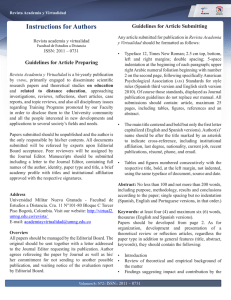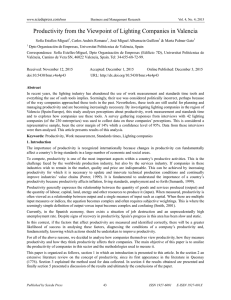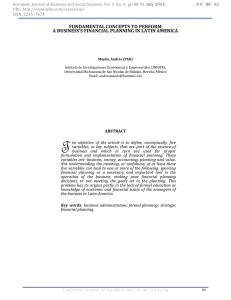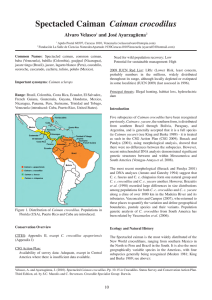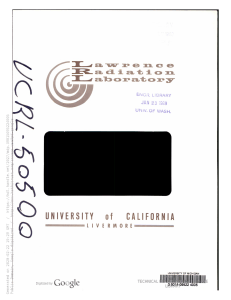Electrophoretic proteinogram reference interval from Argentina
Anuncio
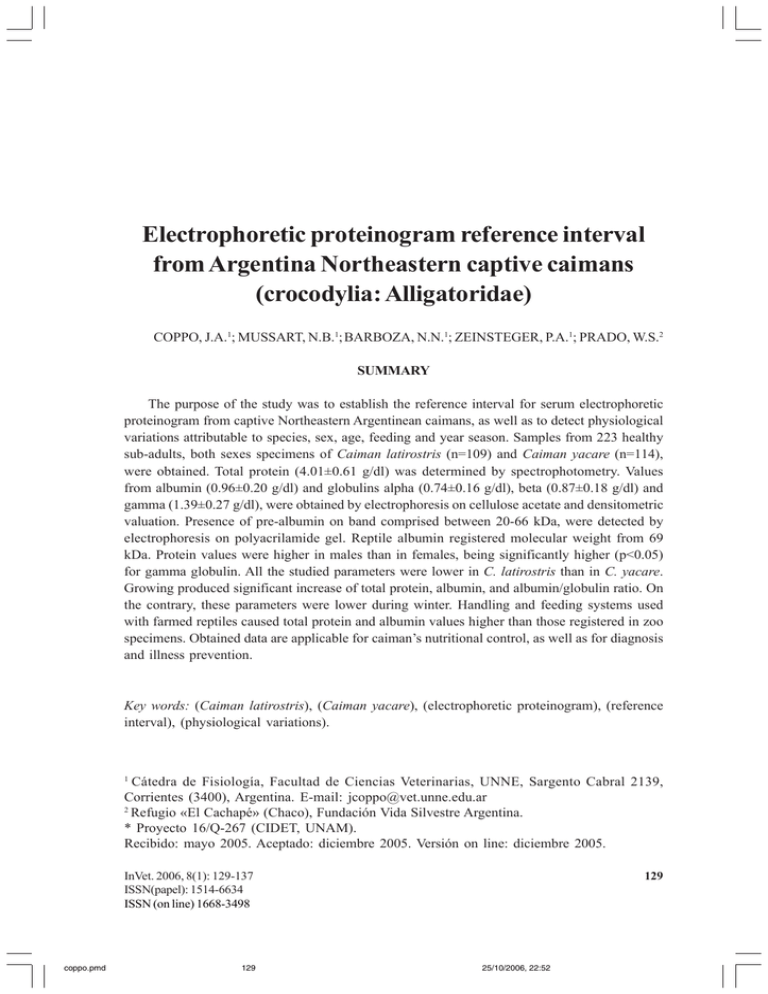
Electrophoretic proteinogram reference interval from Argentina Northeastern captive caimans (crocodylia: Alligatoridae) COPPO, J.A.1; MUSSART, N.B.1; BARBOZA, N.N.1; ZEINSTEGER, P.A.1; PRADO, W.S.2 SUMMARY The purpose of the study was to establish the reference interval for serum electrophoretic proteinogram from captive Northeastern Argentinean caimans, as well as to detect physiological variations attributable to species, sex, age, feeding and year season. Samples from 223 healthy sub-adults, both sexes specimens of Caiman latirostris (n=109) and Caiman yacare (n=114), were obtained. Total protein (4.01±0.61 g/dl) was determined by spectrophotometry. Values from albumin (0.96±0.20 g/dl) and globulins alpha (0.74±0.16 g/dl), beta (0.87±0.18 g/dl) and gamma (1.39±0.27 g/dl), were obtained by electrophoresis on cellulose acetate and densitometric valuation. Presence of pre-albumin on band comprised between 20-66 kDa, were detected by electrophoresis on polyacrilamide gel. Reptile albumin registered molecular weight from 69 kDa. Protein values were higher in males than in females, being significantly higher (p<0.05) for gamma globulin. All the studied parameters were lower in C. latirostris than in C. yacare. Growing produced significant increase of total protein, albumin, and albumin/globulin ratio. On the contrary, these parameters were lower during winter. Handling and feeding systems used with farmed reptiles caused total protein and albumin values higher than those registered in zoo specimens. Obtained data are applicable for caiman’s nutritional control, as well as for diagnosis and illness prevention. Key words: (Caiman latirostris), (Caiman yacare), (electrophoretic proteinogram), (reference interval), (physiological variations). 1 Cátedra de Fisiología, Facultad de Ciencias Veterinarias, UNNE, Sargento Cabral 2139, Corrientes (3400), Argentina. E-mail: jcoppo@vet.unne.edu.ar 2 Refugio «El Cachapé» (Chaco), Fundación Vida Silvestre Argentina. * Proyecto 16/Q-267 (CIDET, UNAM). Recibido: mayo 2005. Aceptado: diciembre 2005. Versión on line: diciembre 2005. InVet. 2006, 8(1): 129-137 ISSN(papel): 1514-6634 ISSN (on line) 1668-3498 coppo.pmd 129 129 25/10/2006, 22:52 Intervalo de referencia para el proteinograma electroforético de caimanes del nordeste argentino en cautiverio (Crocodylia: Alligatoridae) RESUMEN El propósito del estudio fue establecer el intervalo de referencia para el proteinograma electroforético sérico de caimanes argentinos en cautiverio, así como detectar variaciones fisiológicas atribuibles a especie, sexo, edad, alimentación y estación del año. Se emplearon 223 ejemplares sanos, sub-adultos de ambos sexos, de las especies Caiman latirostris (n=109) y Caiman yacare (n=114). Las proteínas totales (4,01±0,61 g/dl) fueron determinadas por espectrofotometría. Mediante electroforesis en acetato de celulosa y valoración densitométrica, se obtuvieron valores para albúminas (0,96±0,20 g/dl) y globulinas alfa (0,74±0,16 g/dl), beta (0,87±0,18 g/dl) y gamma (1,39±0,27 g/dl). Por electroforesis en gel de poliacrilamida se verificaron los pesos moleculares de pre-albúminas (20-66 kDa) y albúminas (69 kDa). Los valores proteicos fueron mayores en machos que en hembras, significativamente para gamma globulinas (p<0,05). Todos los parámetros fueron más bajos en C. latirostris que en C. yacare. El crecimiento produjo aumentos significativos de proteínas totales, albúminas y relación albúminas/globulinas, parámetros que resultaron más bajos en invierno. Los sistemas de manejo y alimentación aplicados en un criadero produjeron valores de proteínas totales y albúminas superiores a los registrados en un zoológico. Los datos obtenidos son aplicables al control nutricional, así como al diagnóstico y prevención de enfermedades de estos reptiles. Palabras clave: (Caiman latirostris), (Caiman yacare), (proteinograma electroforético), (intervalo de referencia), (variaciones fisiológicas) INTRODUCTION Plasma protein concentration widely varies in different species, between ranges from 15 g/dl in cephalopods to 0.1 g/dl in mollusks. By electrophoresis, proteins can separate in different fractions, mainly pre-albumin, albumin and alpha, beta and gamma globulins; some species possess albumin concentration higher than total globulins, and viceversa2. Some data about serum total protein and albumin values were reported for Argentinean northeastern autochthonous caimans; tough they were obtained by different techniques than those used in the present work5,18,19 (fast methods), InVet. 2006, 8(1): 129-137 ISSN(papel): 1514-6634 ISSN (on line) 1668-3498 130 coppo.pmd and considering a lower sample amount. Correct interpretation of reptile physiological phenomena, as well as appropriate illness diagnosis and nutritional control, require a deep knowledge concerning serum proteins, as they are responsible of important functions such as transport, nutrition, clotting, immunity, enzymatic control, acid-base balance, internal environment viscosity and coloidosmotic pressure maintenance2,8,10. The objective of this study was to obtain the reference interval for serum protein electrophoretical fractions from captive Caiman latirostris and Caiman yacare, as well as to establish eventual differences attributable 130 25/10/2006, 22:52 to species, sex, age, feeding and season of the year. MATERIALS AND METHODS Experimental subjects. During 2 years (2003-2004), 223 sub-adults20 caimans, 50% each sex, clinically healthy, from C. latirostris (n=109) and C. yacare (n=114) species, were studied. Health state was tested by exams of general state, dynamism, vivacity, appetite, skin and mucous coloration, and absence of external lesions. Some of them (n=29) were maintained at the Zoo of Corrientes City, in small ponds, without roof, with running water, which was constantly renovated; they were fed on chicken viscera and fish. Remaining animals (n=194) were housed at the «El Cachapé» farm (Chaco, northeastern Argentina), in roofed tanks with underground water, which was renewed daily and stayed at 27 ± 3ºC (heated by gas), fed on meat flour supplemented with vitamins and minerals; sporadically they received bovine viscera. To evaluate growth, reptiles were divided in 3 development stages, considering live weight and corporal longitude. Blood sampling. Hematic and morphometric studies were performed 4 times/ year, in each season, during morning hours (8-9 h a.m.), after 12 h fast. Live weight was obtained using a portable balance and corporal dimensions were evaluated by means of a metallic tape measure. Blood sampling was carried out by means of post occipital venous sinus punction9, while reptile was manually held and his jaw remained tied. Blood was placed in glass tubes and once coagulated it was centrifuged to obtain serum, which was maintained cooled at 5ºC until its analysis, which was made before 3 hours post-extraction. Laboratory techniques. Total protein concentration was determined in a L.Mannheim 4010 spectrophotometer (biuret method, 540 nm, Wiener Lab reagents)10. Protein fractions were separated by electrophoresis on cellulose acetate (Cellogel) and quantified at 610 nm in an automated Citocon CT-440 densitometer 10,13 , equipped with a microprocessor for protein fraction calculations, and a printer module. Electrophoresis on polyacrilamide gel (SDSPAGE under reductive conditions, Sigma) was also made13. All biochemical determinations were checked by a quality control system, using reference patterns and molecular weight markers, as bovine serum albumin (66 kDa), ovalbumin (45 kDa), gliceraldehyde-3phosphate-dehydrogenase (36 kDa), carbonic anhydrase (29 kDa), tripsinogen (24 kDa), trypsin inhibitor (20 kDa), and alphalactalbumin (14.2 kDa). Statistical analysis. A totally randomized design was used. Distributive normality was verified by Wilk-Shapiro test (WS). Parametric statistics included measures from central tendency (arithmetic mean, x) and dispersion (standard deviation, SD). Fiduciary probability was evaluated by confidence intervals (CI±95%). Homogeneity of the variance was verified by Bartlett test. Analysis of variance (ANOVA) was made by one-way linear model. Mean comparisons were carried out by Tukey test. Coefficient of lineal association was evaluated by correlation (Pearson test). Calculations were made with the aid of a statistical software (Statistix 1996). For all inferences a 5% significance was specified, below which the equality null hypothesis was rejected. RESULTS Global values obtained for both reptile species are shown in Table 1. WS coefficients reveal an approximately normal distribution. InVet. 2006, 8(1): 129-137 ISSN(papel): 1514-6634 ISSN (on line) 1668-3498 coppo.pmd 131 131 25/10/2006, 22:52 Data dispersion (SD) did not exceed the limits recommended by parametric statistics. Confidence intervals were adjusted around arithmetic means, but individual ranges were wide. Proteinograms on cellulose acetate obtained in C. latirostris and C. yacare are shown in Figure 1. They reveal the presence of albumin and globulins alpha, beta and gamma, but not of pre-albumin. Slight differences in migration velocity were registered between species. In Figure 2, serum fractions from both crocodile species obtained by polyacrilamide gel electrophoresis, are compared to those from reference patterns, as well to those registered in human beings. Low pre-albumin quantities are evidenced. Confronting simultaneously sera versus molecular weight markers, differences between human beings and reptiles stand out, but differences among reptiles are not registered. Values obtained on each studied species are shown in Table 2. Total protein, beta and gamma globulins were significantly higher in C. yacare (p < 0.05). Gamma globulin concentration was higher in males (Table 3). When growth progressed, increases of total protein, albumin and albumin/globulin ratio were registered. Significantly higher total protein and albumin levels were registered in spring and summer; concentrations decreased during autumn and reached the lowest values in winter (Table 4). Food supplied in the farm promoted values of total protein, albumin and albumin/globulin ratio higher than those registered in the zoo. Pearson test revealed high linear association degree (p<0.05) between live weight and variables as total longitude (r = 0.90), muzzle-tail longitude (r = 0.83), head longitude (r = 0.79), head wide (r = 0.86), and thoracic perimeter (r = 0.88). Considering growth stages, live weight correlated to total Figure 2. Polyacrilamide gel electroforesis from C. latirostris (2, 3, 4), C. yacare (6, 7, 8) and human beings (1, 9). In channel 5 run a reference pattern, which included (from top to bottom), markers of 66, 45, 36, 29, 24, 20 and 14,2 kDa. Pre-albumin presence was evident in all cases (arrows). protein (r = 0.92; p = 0.01), albumin (r = 0.89; p = 0.03) and albumin/globulin ratio (r = 0.94; p = 0.001). Increase of total longitude also correlated to the rise of same proteic variables. InVet. 2006, 8(1): 129-137 ISSN(papel): 1514-6634 ISSN (on line) 1668-3498 132 coppo.pmd Figure 1. Cellulose acetate electrophoresis from C. latirostris (1, 3, 5) and C. yacare (2, 4, 6). Slight differences on migration velocity were registered on each species protein fractions. 132 25/10/2006, 22:52 Table 1. Obtained values in total studied population (n = 223) Total protein (g/dl) ξ ± SD 4.01 ± 0.61 Parame te r WS CI ± 95% Range 0.995 3.91 - 4.08 2.30 - 5.84 albumin (g/dl) 0.96 ± 0.20 0.981 0.93 - 0.99 0.50 - 1.65 alpha globulin (g/dl) 0.74 ± 0.16 0.985 0.72 - 0.77 0.34 - 1.29 beta globulin (g/dl) 0.87 ± 0.18 0.988 0.84 - 0.90 0.42 - 1.41 gamma globulin (g/dl) 1.39 ± 0.27 0.988 1.34 - 1.44 0.50 - 2.50 total globulins (g/dl) 3.02 ± 0.22 0.987 2.89 - 3.14 1.97 - 4.16 album./globul. ratio 0.31 ± 0.06 0.986 0.30 - 0.32 0.14 - 0.51 ξ: arithmetic mean, SD: standard deviation, WS: Wilk-Shapiro distributive normality test (critical value: 0.947, α = 0.05), CI±95%: confidence interval. Table 2. Obtained values on each species C. latirostris (n = 109) Parame te r C. yacare (n = 114) ξ ± SD CI ± 95% ξ ± SD CI ± 95% total protein (g/dl) 3.88 ± 0.62 a 3.76 - 3.99 4.10 ± 0.59 b 3.99 - 4.22 albumin (g/dl) 0.98 ± 0.19 0.92 - 1.01 0.95 ± 0.20 0.91 - 0.99 alpha globulin (g/dl) 0.75 ± 0.14 0.71 - 0.79 0.73 ± 0.15 0.70 - 0.76 beta globulin (g/dl) 0.82 ± 0.18 a 0.77 - 0.86 0.93 ± 0.18 b 0.89 - 0.96 gamma globulin (g/dl) 1.33 ± 0.25 a 1.26 - 1.39 1.46 ± 0.27 b 1.38 - 1.54 total globulins (g/dl) 2.92 ± 0.23 a 2.83 - 3.04 3.13 ± 0.25 b 3.02 - 3.24 album./globul. ratio 0.32 ± 0.07 0.31 - 0.34 0.30 ± 0.05 0.28 - 0.31 ξ: arithmetic mean, SD: standard deviation, CI±95%: confidence interval. In each line, different letters indicate significant differences (Tukey test, p < 0.05). Table 3. Variations according to sex, live weight, and total longitude in both species (ξ) Se x Parame te r male 4.03 0.97 0.75 0.84 1.44 a 3.04 0.33 total protein (g/dl) albumin (g/dl) alpha globulin (g/dl) beta globulin (g/dl) gamma globulin (g/dl) total globulins (g/dl) album./globul ratio female 3.98 0.95 0.77 0.88 1.36 b 3.02 0.30 Live we ight (kg) < 3.5 3.90 a 0.90 a 0.78 0.84 1.38 2.99 0.30 a 3,6-5,0 3.96 a 0.92 a 0.76 0.89 1.37 3.03 0.30 a Total longitude (cm) >5 4.18 b 1.16 b 0.71 0.88 1.41 3.00 0.37 b < 99 3.92 a 0.94 a 0.74 0.87 1.36 2.96 0.30 a 100-110 3.94 a 0.92 a 0.73 0.88 1.39 3.01 0.29 a > 110 4.15 b 1.13 b 0.73 0.85 1.41 2.98 0.36 b ξ: arithmetic mean. In each line, different letters indicate significant differences (Tukey test, p < 0.05). InVet. 2006, 8(1): 129-137 ISSN(papel): 1514-6634 ISSN (on line) 1668-3498 coppo.pmd 133 133 25/10/2006, 22:53 Table 4. Variations according to year season and feeding system in both species (ξ) Ye ar se ason Parame te r spring total protein (g/dl) 4.19 a summer 4.15 a Fe e ding autumn 3.88 b winter 3.71 c farm 4.12 zoo a 3.93 b albumin (g/dl) 1.17 a 1.13 a 0.82 b 0.69 c 1.08 a 0.88 b alpha globulin (g/dl) 0.73 0.77 0.74 0.75 0.80 0.78 beta globulin (g/dl) 0.87 0.88 0.84 0.88 0.83 0.84 gamma globulin (g/dl) 1.37 1.33 1.45 1.42 1.38 1.41 total globulins (g/dl) 2.98 2.99 3.02 3.04 3.00 3.02 album./globul. ratio 0.37 a 0.36 a 0.28 b 0.24 b 0.35 a 0.29 b ξ: arithmetic mean. In each line, different letters indicate significant differences (Tukey test, p < 0.05). DISCUSSION Eventual variations due to postprandial effect and circadian rhythm were excluded from the experimental design, because samples were taken during fast, in uniform morning hours. In crocodiles, fast lack causes hyperlipemia and interferes with photometric determinations 12 . Wide individual ranges verified in this study should be attributed to reptilian physiologic particularities, because its blood parameters fluctuate considerably due to feeding system, habitat, climate and sex19. Blood values from other aquatic animals, such as amphibians, also register greater oscillations due to their scarce regulation mechanisms, and to a higher tolerance to hemodilution and hemoconcentration8. Cellulose acetate electrophoresis allowed to separate albumin and globulins alpha, beta and gamma, but not pre-albumin. The latter was evidenced by polyacrilamide gel electrophoresis, which also permitted to know that the albumin of C. latirostris and C. yacare possess a molecular weight similar to those reported for human beings albumin (69 kDa)13, because it was located nearby to the 66 kDa marker. Reptile pre-albumin was located between the bands InVet. 2006, 8(1): 129-137 ISSN(papel): 1514-6634 ISSN (on line) 1668-3498 134 coppo.pmd from 20 to 66 kDa, in consonance to those of human beings, which stays below 61 kDa13. In human beings, pre-albumin includes important proteins as antitrypsin, acid glycoprotein, thyroxine-binding-prealbumin (T4 hormone carrier), and others; pre-albumin increase is uncommon, it occur in certain nephrosis; decrease of this fraction indicates hepatic insufficiency or tissue destructions10. Mean values obtained in the present study are lower than those reported from juvenile and adult specimens of captive C. latirostris, for total protein (5.01±1.14 g/dl), albumin (2.42±2.33 g/dl) and globulins (3.1±3.1 g/dl)18. Other authors also found high values for the same parameters, from 5.06±0.87 g/dl, 1.66±0.30 g/dl, 3.37±0.85 g/dl and 0.53±0.21 respectively, on 12 juvenile farmed C. latirostris specimens19. On the other hand, from 5 C. yacare captive specimens, last authors obtained values of total protein (4.28±0.29 g/dl), albumin (0.95±0.22 g/dl), globulins (3.33±0.24 g/dl) and albumin/ globulin ratio (0,29±0,07) similar to those found in the present trial. Concentrations of total protein obtained on 65 farmed specimens from C. latirostris (3.80±0.14 g/dl) 5 resulted similar to those 134 25/10/2006, 22:53 determined in the present study on the same species, but remaining proteinogram values were very different. On 33 captive C. yacare specimens, same authors obtained values of total protein (4.48±0.20 g/dl), albumin (1.43±0.05 g/dl) and albumin/globulin ratio (0.50±0.07), which were higher to those found by us on same species, as long as globulin levels resulted similar (3.08±0.19 g/dl). On exotic Crocodylus porosus healthy yearling specimens, values of total protein (4.1-7.0 g/dl), albumin (1.4-2.3 g/dl), and globulins (2.7-5.0 g/dl) were obtained12, which resulted higher than those found here. For the same parameters, values of 6.2±1.1 g/dl, 1.8±0.3 g/dl, and 4.4±0.9 g/dl respectively, were determined in Alligator mississippiensis15. In other trials, total protein values from 5.1 g/dl and 6.5 g/dl were registered respectively on A. mississippiensis and Crocodylus acutus17. On Crocodylus niloticus, total protein values of 5.3 g/dl6 and 5.0 g/dl21, as well as albumin concentration of 1.9 g/dl and globulin level of 3.1 g/dl6, were reported. Several authors mentioned above do not describe the techniques used in their works. Other investigators employed dry chemistry methods (reactive strips) 19. Some of them obtained globulin values by difference between total protein and albumin18. According to each case, heparinized plasma or serum were employed. None of them used electrophoretical techniques. At the light of this research is very difficult to make comparison especially because in certain group of studies, reptiles were not divided according to sex, age, or year season. Photocolorimetric technique used to determine albumin not always gives values coincident to those obtained by electrophoresis and densitometry; the latter are trustworthier because the sum of protein fractions adjusts exactly to the total proteinemia value10. Blood extraction technique, not always detailed in consulted studies, could be another cause of values variation9. Total protein values obtained in present trial were lower in C. latirostris than in C. yacare, contrary to data reported in another investigation19. Autochthonous reptiles studied did not register significant differences attributable to sex (except gamma globulin), in opposition to data reported for other crocodile species16. In frogs of aquatic life, which are phylogenetically related to reptilians, serum protein concentration is higher in males than in females, significantly for total protein (4,41 versus 4,32 g/dl, p <0,05), and not significantly for albumin and gamma globulin3. Growth causes considerable changes on certain crocodile blood parameters, just as it was checked for Crocodylus porosus from 1 year old versus 2-4 years old1,12. Our findings on Caiman genus endorse this fact, being corroborated by high linear association coefficients registered between growth progress and increases of total protein, albumin and albumin/globulin ratio. In this study, rise of proteinemia should necessarily be attributed to increase of albumin and gamma globulin, because alpha and beta globulins registered low and irregular oscillations. Globulin gamma serum increase may be responds to increment of antibodies synthesis promoted by the immunologic system progressive maturation, just as it happens in other species2. Gradual albumin increase, which was parallel to caiman development, could be compared to the ontogenetic increase registered in amphibians; in tadpoles (aquatic life) albumins are almost absent, but they appear in mature toad due to necessity of retaining intravascular water during terrestrial life8. In coincidence, on 300 Rana catesbeiana InVet. 2006, 8(1): 129-137 ISSN(papel): 1514-6634 ISSN (on line) 1668-3498 coppo.pmd 135 135 25/10/2006, 22:53 specimens controlled from 9 to 21 months of age, growth correlated to significant increases of total protein (9 months: 3.81 g/dl versus 21 months: 4.90 g/dl), albumin (1.38 versus 1.80 g/dl), and globulins beta (0.65 versus 0.89 g/dl) and gamma (1.17 versus 1.52 g/dl)3. Our results indicate that cold climate influenced unfavorably on proteinemia and albuminemia from captive reptiles, even on those protected by heating. On farmed bullfrogs, cease of feeding during winter lethargy also causes depletion of serum proteins, mainly albumins3. Wintry consumption of tissular reserves can cause severe malnutrition on crocodiles 15. A group of C. latirostris maintained during 2 months at higher environmental temperature (22ºC) than a control group (18ºC), obtained higher live weight and corporal longitude14. Zoo alimentary system caused lower total protein and albumin rates than those registered on farmed caimans. Alimentary inadequacies are reflected on serum protein concentrations2. Total protein and albumin serum values from R. catesbeiana were directly proportional to dietary protein quantity and quality3. The change from a habitual food (bovine meat) to a new diet (flour of meat and blood) produced serum albumin increase in caimans from northeastern Argentina5. Caimans, as all carnivorous reptiles, require high quality dietary protein during captivity, able to replace the preys that constitute their natural feeding; in warm climates, crocodile malnutrition is more deleterious due to its simultaneous metabolic increase 4 . Crocodile hypoproteinemia is related with immunitary depression, because amino acids deficit interfere with the appropriate inmunoglobulin synthesis11. Preys captured by reptiles in natural life provide adequate levels of essential amino acids, lipids, vitamins, minerals and trace elements, ACKNOWLEDGMENTS To Dra. L.C. Leiva (Facena, UNNE), for her important technical collaboration. BIBLIOGRAPHY 1. CANFIELD, P.J. 1985. Characterization of the blood cells of Australian crocodiles (Crocodylus porosus and C. johnstoni). Zentralbl Vet Med C Anat Histol Embryol 14:269-288. 2. COPPO, J.A. 2001. Fisiología Comparada del Medio Interno. Ed. Dunken, Buenos Aires, 297 p. 3. COPPO, J.A.; MUSSART, N.B.; FIORANELLI, S.A. 2004. Impacto de la alimentación, clima y sistema de manejo del criadero sobre el peso y las proteínas plasmáticas de Rana catesbeiana. Vet Arg 21:101-116. 4. DONOGHUE, S.; LANGERBER, J. 1996. Nutrition. In: MADER, D.R. (ed.): Reptile Medicine and Surgery. Saunders, Philadelphia, p. 148-173. InVet. 2006, 8(1): 129-137 ISSN(papel): 1514-6634 ISSN (on line) 1668-3498 136 coppo.pmd contrary to diet given in captivity7. In such way, biochemical values are useful to evaluate crocodile physiological state and to early detect diseases 19. To optimize caimans breeding systems, it is affirmed that feeding improvement is the current priority5. In conclusion, C. latirostris and C. yacare serum protein reference interval is established starting from numerous sample, by means of trustworthy techniques subjected to quality control. Several differences are verified between species, but variations are scarce between sexes. Growth progress correlates to increases of total protein, albumin and albumin/ globulin ratio. Serum protein changes attributable to feeding type and climate are verified; lowest total protein and albumin values are registered in winter. Obtained values are useful to control nutritional and metabolic state of caimans. 136 25/10/2006, 22:53 5. FERREYRA, H.; UHART, M. 2001. Evaluación y evolución del estado sanitario de Caiman latirostris y Caiman yacare en el Refugio El Cachapé. Boletín Técnico de la Fundación Vida Silvestre Argentina Nº 55, Anexo III: 1-15. 6. FOGGIN, C.M. 1987. Diseases and disease control on crocodile farms in Zimbabwe. In: WEBB, G.J.; MANOLIS, S.C.; WHITEHEAD, P.J. (ed.): Wildlife Management: Crocodiles and Alligators. Surrey Beatty, Chipping Norton, p. 351-362. 7. FRYE, F.L. 1986. Hematology of captive reptiles. In: FOWLER, E.M. (ed.): Zoo and Wild Animal Medicine, 2nd ed. Saunders, Philadelphia, p. 181-184. 8. HOAR, W.S. 1983. General and Comparative Physiology, 3rd ed. Prentice-Hall, New Jersey, 848 p. 9. JACOBSON, E. 1984. Immobilization, blood sampling, necropsy techniques and diseases of crocodilians: a review. J Zoo Anim Med 15:38-45. 10. KALINOV, A. 1984. El Laboratorio y su Interpretación Semiológica, 2º ed. López Libreros, Buenos Aires, 1209 p. 11. KLINGENBERG, R.J. 1996. Therapeutics. In: MADER, D.R. (ed.): Reptile Medicine and Surgery. Saunders, Philadelphia, p. 299. 12. MILLAN, J.M.; JANMAAT, A.; RICHARDSON, K.C.; CHAMBERS, L.K.; FORMIATTI, K.R. 1997. Reference ranges for biochemical and haematological values in farmed saltwater crocodile (Crocodylus porosus) yearlings. Aust Vet J 75:814-817. 13. NEREMBERG, S.T. 1975. Electrophoretic Screening Procedures. Lea & Febiger, Philadelphia, 245 p. 14. PIÑA, C.; LARRIERA, A. 2002. Caiman latirostris growth: the effect of a management technique on the supplied temperature. Aquaculture 211:387-392. 15. SCHOEB, T.R.; HEATON-JONES, T.G.; CLEMMONS, R.M.; CARBONNEAU, D.A.; WOODWARD, A.R.; SHELTON, D.; POPPENGA, R.H. 2002. Clinical and necropsy findings associated with increased mortality among american alligators of Lake Griffin, Florida. J Wildl Dis 38:320-337. 16. STACY, B.A.; WHITAKER, N. 2000. Hematology and blood biochemistry of captive mugger crocodiles (Crocodylus palustris). J Zoo Wildl Med 31:339-347. 17. STEIN, G. 1996. Hematologic and blood chemistry values in reptiles. In: MADER, D.R. (ed.): Reptile Medicine and Surgery. Saunders, Philadelphia, p. 248-257. 18. TROIANO, J.C.; ALTHAUS, R. 1994. Hallazgos hematológicos en Caiman latirostris (Crocodylia: Alligatoridae) en condiciones de cautiverio. Memorias del IV Workshop sobre Conservación y Manejo del Yacaré Overo, Santo Tomé (Santa Fe, Argentina), p. 12-24. 19. UHART, M.; PRADO, W.; BELDOMÉNICO, P.; ROSSETTI, C.; FERREYRA ARMAS, M.C.; MARTÍNEZ, A.; BARDÓN, J.C.; AVILÉS, G.; KARESH, W. 2001. Estudios sanitarios comparativos de yacarés (Caiman latirostris y Caiman yacare) silvestres y cautivos. Boletín Técnico de la Fundación Vida Silvestre Argentina Nº 55:39-50. 20. WALLER, T.; MICUCCI, P.A. 1993. Relevamiento de la distribución, hábitat y abundancia de los crocodilios de la Provincia de Corrientes, Argentina. Memorias de la 1ra. Reunión Regional del Grupo de Especialistas en Cocodrilos, Santa Marta, Colombia, p. 341-385. 21. WATSON, P.A. 1990. Effects of blasting on Nile crocodiles, Crocodylus niloticus. Proceedings of the 10th Working Meeting of the Crocodile Specialist Group IUCN, Gainsville, Florida, USA, p. 240-252. InVet. 2006, 8(1): 129-137 ISSN(papel): 1514-6634 ISSN (on line) 1668-3498 coppo.pmd 137 137 25/10/2006, 22:53

